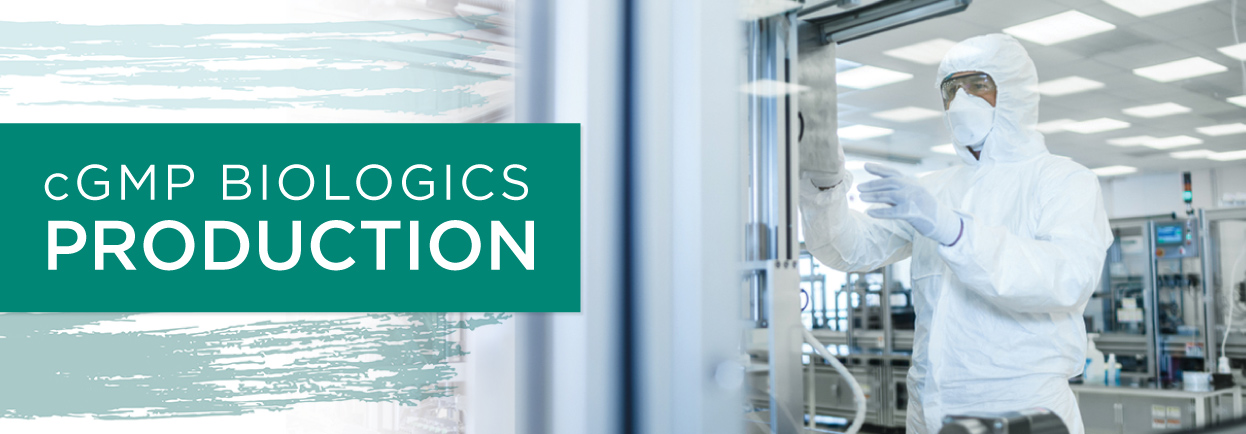cGMP Biologics Production
Producing biologics is largely dependent on harnessing naturally occurring mechanisms to generate the agent of choice. As small molecular agents make up the bulk of biologics being investigated and used today, cells and cellular mechanisms are the focal point for the majority of manufacturing workflows.Factory Building: Cell-based Biologics Production
The production of customized biologics requires the insertion and integration of genetic material encoding the altered agent. This can be accomplished in a variety of ways. Viral vectors are capable of injecting their nucleic acid payload directly into cells, while naked nucleic acids or bacterial plasmids require cell permabilization using transfection techniques such as electroporation and lipofection. Alternatively, rather than inserting the final product into the cellular genome, scientists can introduce gene editing machinery (e.g., the CRISPR or Cre-LoxP systems) that may even be activated at a later time using a trigger.1,2 The efficacy and stability of the transfection/transduction depends on a number of factors, including the host cell type, host cell health and viability, the composition of the genetic material, the intended integration location, the reagents/vectors used, and environmental conditions (e.g., pH).3To increase production to meet shifting demand, scientists can increase production efficiency, increase the number of producing entities, or both. Clonal selection and expansion are one way to accomplish both, and they are especially important when producing allogeneic biologics–where the number of potential production cells is limited. Here, genetically heterogeneous populations of agent-producing cells are monitored and evaluated for productivity and stability. The most productive clones, once identified, can then be extracted and expanded to create new cell populations bearing the original progenitor’s elevated productivity.4 Given that primary cells have relatively short lifespans in culture, establishing cell populations/lines capable of sustained production over multiple generations is key to ensuring consistent production throughput.
Overcoming Obstacles, Optimizing Output
Biological systems are highly sensitive and responsive to minute stimuli. In vivo, this adaptability is a tremendous advantage, allowing organisms to activate highly specific responses to almost any circumstance. However, for biologics production, it represents a significant obstacle. The inherent variations between individual cells, whether genetic or phenotypic, means that the agents produced by two different cells within the same culture or between batches may not be identical. Small deviations in sequence, size, or shape can lead to considerable differences in efficacy, affinity, and side effects.Scientists are limited in the steps they can take to counter this; even two identical genetic clones can respond differently to the same stimuli or experience different spontaneous mutations over the passage of time. However, what scientists can do is identify undesired production units and products and remove them. Techniques such as centrifugation and filtration separate particles based on physical properties such as size or charge are not only used to separate biologics within a sample from cells and debris, but are also ideal for eliminating defective agent particles (e.g., misfolded or aggregated proteins) from heterogeneous samples.
Hands On and Hands Off at the Same Time
Although scientists today have more control over the design and manufacture of biologics than ever before, the production of biological agents is still largely automated to a great extent, given its reliance on the utilization of endogenous mechanisms present in biological systems. This key difference between biologics and synthetic pharmaceuticals contributes to several unique challenges that researchers must be aware of when initiating and implementing biologics production workflows.
References
- K.I. Liu et al., “A chemical-inducible CRISPR-Cas9 system for rapid control of genome editing,” Nat Chem Biol, 12(11):980-987, 2016.
- C.G. Geoffroy and O. Raineteau, “A Cre-lox approach for transient transgene expression in neural precursor cells and long-term tracking of their progeny in vitro and in vivo,” BMC Dev Biol, 7:45, 2007.
- T.K. Kim and J.H. Eberwine, “Mammalian cell transfection: the present and the future,” Anal Bioanal Chem, 397(8): 3173-3178, 2010.
- F. Li et al., “Cell culture processes for monoclonal antibody production,” MAbs, 2(5):466-479, 2010.


